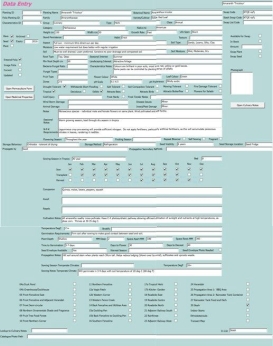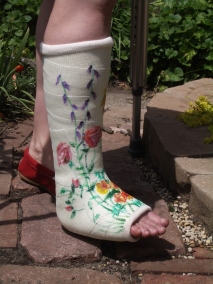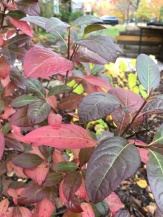3. August, 2017
Planted: A Year of Gardening
The series starts here
I wrapped up July and started August by landscaping my sister- and brother-in-law’s house. They aren’t gardeners; Mary, my sister-in-law, views the garden the way Fran Leibowitz viewed the sidewalk—it’s what have to cross in order to get to the cab. I suggested a backyard seating area, bright flowers, a fruit tree. All got rejected, on the theory (knowledge) that they had never and would never sit outside. So I ended up putting in five different essentially maintenance-free ground covers: three varieties of bugleweed, a sedum, and chameleon plant. A lot of corners were filled with divided iris, lily-of-the-valley and hosta from other parts of the yard, as well as both scavenged and transplanted shrubs.
My landscape designer friend Maureen says that “maintenance free” is the holy grail for the kinds of people who hire landscapers to put in their gardens. And ground cover is pretty maintenance free; once established you never have to mow, or even weed very much, as it crowds out even aggressive weeds.
A new planting, however, is not maintenance free. You have to weed, and water, until it fills in, which can take a couple of years, especially if you don’t invest in enough plantings to fill the space. We could have used double the number we planted, but it wasn’t in the budget.
Mary says she hates “gardening.” I would just like to clarify that “taking care of the yard” is not the same thing as “gardening.” Saying that you let your lawn and plantings go to hell because you hate to garden is like saying that you never clean your house because you hate to build furniture.
The yard at my in-laws’ two-flat was, to put it charitably, a disaster 30 years in the making. As I joked to neighbors walking by while I worked, you have to do this at least every 40 years whether it needs it or not. It gets no full sun—at best it gets dappled shade. When they moved in, they put in a barberry hedge (because nothing says good neighbors like a thorn hedge—were they hoping to catch the fleece of the golden sheep?) and then never trimmed it. Ditto the spirea and a vicary golden privet. The barberry was overgrown, tangled and half dead.
I started by covering both the front and back with heavy black plastic to kill the weeds, leaving it there for 6 weeks. I shaped, pruned, and trimmed the barberry so that you can see the vase-shaped structure of the plant, but leaving a fountain of branches overhead. A lovely and unusual form for barberries, which people generally cut into little box shapes with power trimmers. I did get several helpful neighbors and my mother in law telling me that I was doing it wrong, and must cut it all even. Thanks for the (unsolicited) input, but no.
At the end of the month my son Seng and I started planting the ground covers. When I pulled off the black plastic the weeds were all gone, but a lovely moss was thriving. Unfortunately, six weeks dry had turned the soil into concrete.
I marked off the patches for the bugleweed (ajuga), a sedum, and dead nettle (lamium). We got 2 of the ajugas and the deadnettle planted, about 300 plants, before we cashed it in. I came back on my own twice to finish the front, and then a third time for the backyard. I had originally thought Seng and I would be able to plant the whole property in a single day. We thought we could dig out individual holes with trowels, but in the end had to use the big spade to turn and break up the soil.
I did the last two plantings on my own, but because they’d been watering, the soil was mercifully looser and it went fairly fast. The yard should bloom in succession in the spring, from the pink lamium to the purple ajuge, to the yellow sedum. It didn’t rain, however for the entire month, and the weeds took over. They continued to neglect the new plantings over the course of the following year, with no watering or weeding. The weeds have taken over again.
They should have put in the patio.



 So Folians have been coming up with solutions. For my current gardens, I created Flickr albums with
So Folians have been coming up with solutions. For my current gardens, I created Flickr albums with  Gardener Carol has been setting up an Access database (left; sorry about the size). Kelly, of
Gardener Carol has been setting up an Access database (left; sorry about the size). Kelly, of 
 Some of the community are trying to retain some of what will be lost–connecting to each other, or creating databases in Access or One Note, or photo logs on Flickr, but it won’t be the same integrated motherlode of data and continuity and community.
Some of the community are trying to retain some of what will be lost–connecting to each other, or creating databases in Access or One Note, or photo logs on Flickr, but it won’t be the same integrated motherlode of data and continuity and community.


 The memory stones–repository for the things I have lost–sit in the heavy rain that impedes the work. The morning dew has that heavy cold sparkle that says “I want to be frost”.
The memory stones–repository for the things I have lost–sit in the heavy rain that impedes the work. The morning dew has that heavy cold sparkle that says “I want to be frost”. potted plants are brought inside for the winter. When I was younger I would do it all in late October in a couple of marathon days. Now I spread it out over weeks, and wonder about the time when I won’t be able to do this anymore.
potted plants are brought inside for the winter. When I was younger I would do it all in late October in a couple of marathon days. Now I spread it out over weeks, and wonder about the time when I won’t be able to do this anymore.

 I used to live a 15-minute walk from Chicago’s lakefront. I chose the new place partially for that proximity but it’s an additional 30 minute walk; a little more of a commitment. I seriously considered buying a condo off one of these beaches, but decided I couldn’t live without a garden of my own.
I used to live a 15-minute walk from Chicago’s lakefront. I chose the new place partially for that proximity but it’s an additional 30 minute walk; a little more of a commitment. I seriously considered buying a condo off one of these beaches, but decided I couldn’t live without a garden of my own.



 There’s a creek running through Meadowbrook, with several charming bridges along the path. When I was living nearby there was no creek. Like the creeks in Manhattan, it had been drained and buried and diverted to accommodate the farm. It has also now been restored.
There’s a creek running through Meadowbrook, with several charming bridges along the path. When I was living nearby there was no creek. Like the creeks in Manhattan, it had been drained and buried and diverted to accommodate the farm. It has also now been restored.



